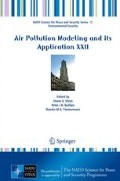Abstract
An attempt has been made by a combination of theory, observations, and especially modeling to determine the concentrations of trace gases and aerosols in the troposphere, without the influence of human beings.
Access this chapter
Tax calculation will be finalised at checkout
Purchases are for personal use only
References
Andreae M (2007) Aerosol before pollution. Science 315(5808):50–51
Roelofs G-J, Lelieveld J, van Dorland R (1997) A three-dimensional chemistry/general circulation model simulation of anthropogenically derived ozone in the troposphere and its radiative forcing. J Geophys Res 102(D19):23389–23401
Roelofs G-J, Lelieveld J, Feichter J (1998) Model simulations of the changing distribution of ozone and its radiative forcing of climate: past, present and future. Max. plamck-Inst. of Meteorology, Hamburg, Germany, Rep. no 283
Volz A, Kley D (1988) Evaluation of the Montsouris series of ozone measurements in the nineteenth century. Nature 332:240–242
Yienger J, Levy H (1995) Empirical model of global soil-biogenic NOx-emissions. J Geophys Res 100:11447–11464
Author information
Authors and Affiliations
Corresponding author
Editor information
Editors and Affiliations
Additional information
Questions and Answers
Questioner name: Sergey Napelenok
Q. How do you classify “wild fires” in your analysis
A. I in fact did not take them into account. Focusing on Europe, most forest fires might be caused by humans
Questioner name: Mark Janssen.
Q. You should be able to include forest fire return frequency and create a good statistical model for forest fires. Fire return frequency is a well understood science in the forestry field
A. Thanks for this information. In case these forest fires are natural fires, it would be useful to take them into account. However, in that case I should also consider the forest coverage in previous times, Europe might well have been nearly completely covered by forest
Questioner name: Stefano Galmarini.
Q. How it looks if you consider “clean air” as that produced in stationary state of interaction between life and the atmosphere. To what extent can we say that prior to the anthropogene the atmosphere reached already not “equilibrium” and onto which the anthropogenic perturbation occurred?. Why not running a super long simulation without man and see what happens?
A. I need to think about this in more detail. The chemical lifetimes of species will play a role there, like the 6,000 years for O2.
Questioner name: Douw G. Steyn.
Q. Have you tried to put your interesting ideas into the context provided by the “big history” movement
A. No, I didn’t, but will certainly have a look into this.
Rights and permissions
Copyright information
© 2014 Springer Science+Business Media Dordrecht
About this paper
Cite this paper
Builtjes, P., Kranenburg, R. (2014). Modelling Clean Air. In: Steyn, D., Builtjes, P., Timmermans, R. (eds) Air Pollution Modeling and its Application XXII. NATO Science for Peace and Security Series C: Environmental Security. Springer, Dordrecht. https://doi.org/10.1007/978-94-007-5577-2_46
Download citation
DOI: https://doi.org/10.1007/978-94-007-5577-2_46
Published:
Publisher Name: Springer, Dordrecht
Print ISBN: 978-94-007-5576-5
Online ISBN: 978-94-007-5577-2
eBook Packages: Earth and Environmental ScienceEarth and Environmental Science (R0)

